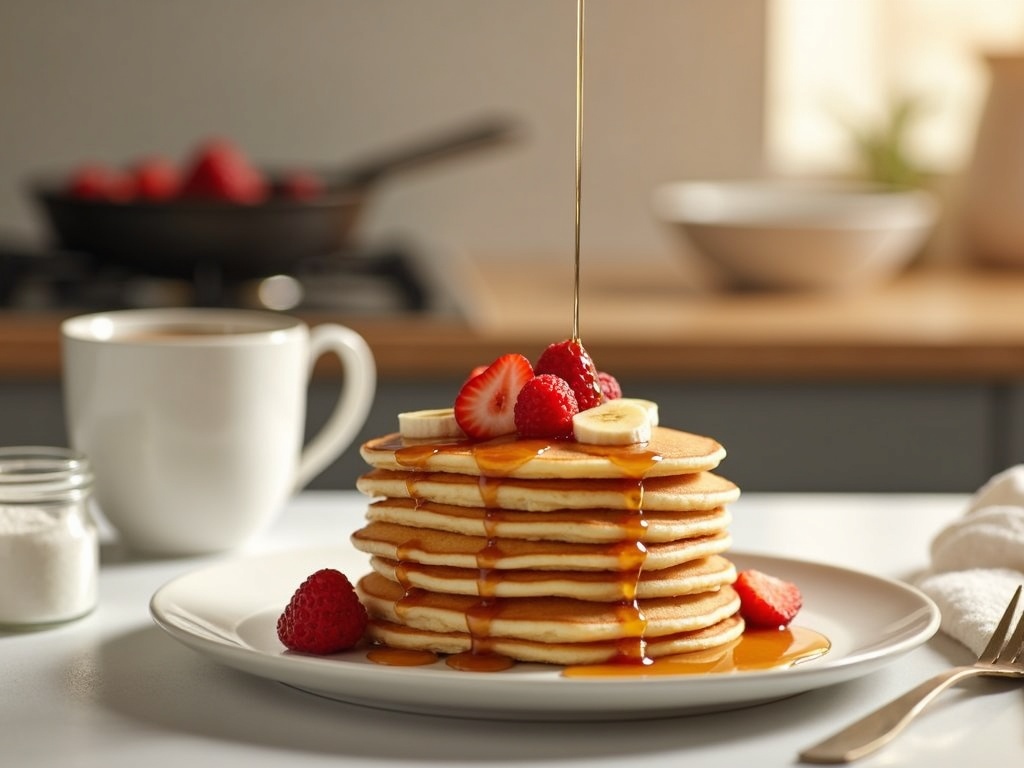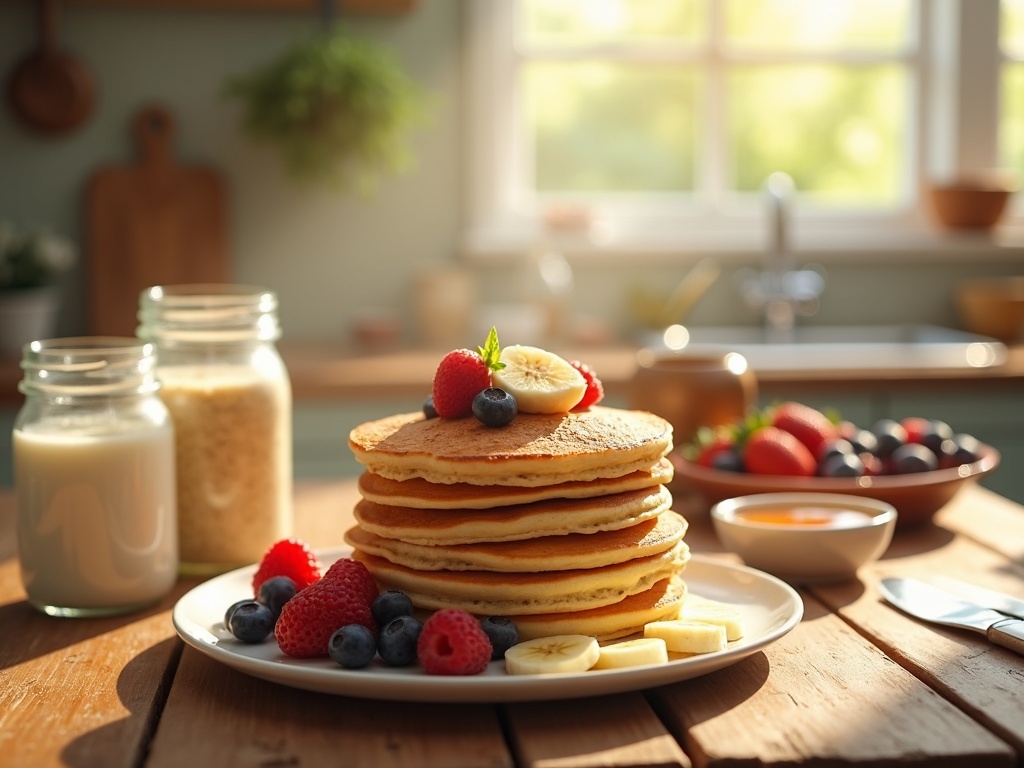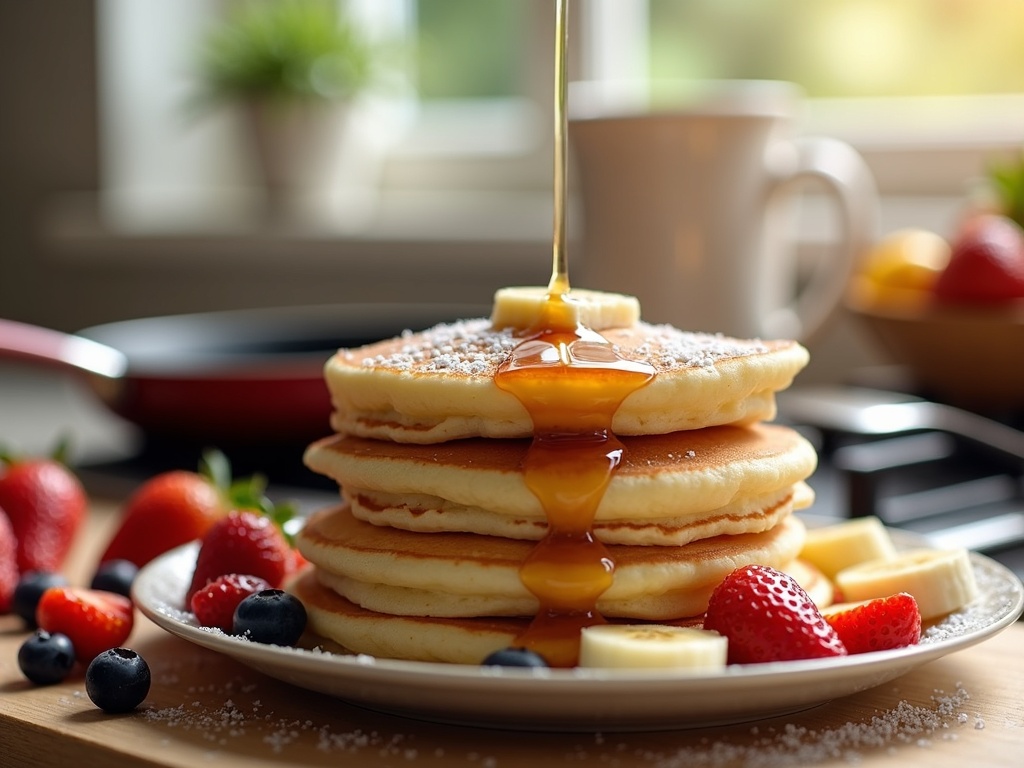This quick pancake recipe transforms simple pantry staples into fluffy, golden pancakes in just 15 minutes from start to finish. The straightforward process combines basic ingredients with proper cooking techniques to create consistently delicious results that can be customized to fit various dietary needs and flavor preferences.
Find In This Article
Key Takeaways
- The recipe uses just 8 common ingredients and takes only 10 minutes of prep time followed by 5 minutes of cooking time.
- Each pancake contains approximately 90 calories with a balanced nutritional profile of protein, carbohydrates, and fat.
- The secret to perfect texture is not overmixing the batter – small lumps create ideal fluffiness.
- The recipe is highly adaptable for dietary restrictions like vegan, gluten-free, or whole wheat variations.
- Pancakes can be served with traditional toppings like maple syrup or elevated with fresh fruit, nut butters, or chocolate for variety.
Perfect Pancakes in Just 15 Minutes
I’ve mastered the art of making delicious pancakes in just 15 minutes flat. This recipe has become my go-to for busy mornings when I need something satisfying but don’t have much time to spare. It’s perfect for beginners and experienced cooks alike, yielding 8 fluffy pancakes that serve 4 people (2 pancakes per serving).
Quick Ingredients & Prep (10 minutes)
The beauty of this quick pancake recipe lies in its simplicity. I start with basic pantry staples that don’t require a special shopping trip:
- 1 cup all-purpose flour
- 2 tablespoons sugar
- 2 teaspoons baking powder
- 1/2 teaspoon salt
- 1 large egg
- 3/4 cup milk
- 2 tablespoons melted butter
- 1 teaspoon vanilla extract (optional)
My prep process is straightforward. I mix the dry ingredients in one bowl, the wet ingredients in another, and then combine them with just a few stirs. The key is not to overmix – those small lumps create the perfect texture. This entire prep phase takes just 10 minutes, making it ideal for those hectic mornings when time is limited.
Each pancake contains approximately 90 calories, with 2g protein, 15g carbohydrates, and 3g fat – making them a relatively balanced breakfast option that won’t weigh you down.
Cooking Technique (5 minutes)
The cooking phase is where many people go wrong with pancakes, but I’ve refined my technique to ensure perfect results every time:
- Heat a non-stick pan or griddle over medium heat until a drop of water sizzles on contact.
- Lightly grease the surface with butter or cooking spray.
- Pour 1/4 cup of batter for each pancake, leaving space between them.
- Cook until bubbles form on the surface and edges look set (about 2 minutes).
- Flip once and cook for another minute until golden brown.
The entire cooking process takes only 5 minutes for the full batch. I’ve found that keeping the heat at medium rather than high prevents burning while still cooking quickly.
For extra flavor, I sometimes add fresh berries or sliced bananas directly to the batter on the griddle. This transforms these American pancakes into something special without adding any extra time.
What makes this recipe stand out is its reliability – I get consistently fluffy pancakes every time. The batter has the perfect consistency – not too thick or thin – which means it spreads nicely in the pan without running everywhere.
For serving, I keep it simple with maple syrup, but these pancakes are versatile enough to pair with yogurt, fruit compote, nut butter, or even a dusting of powdered sugar. They’re substantial enough to fuel your morning but light enough that you won’t feel sluggish afterward.
I often double the recipe on weekends and refrigerate the leftovers for quick weekday breakfasts. The pancakes reheat beautifully in the toaster, which means I can enjoy homemade pancakes on even the busiest mornings.
This 15-minute pancake recipe has saved countless mornings at my house. It’s proof that delicious, homemade breakfasts don’t have to be time-consuming or complicated. With minimal ingredients and equipment, anyone can create a satisfying breakfast that feels special but fits into a hectic schedule.

Simple Ingredients for Foolproof Results
Making pancakes doesn’t require a pantry full of exotic ingredients. I’ve found that the best pancakes come from simple, quality basics that most of us already have at home. This American pancakes recipe uses just seven everyday ingredients to create magic on your breakfast table.
The Perfect Pancake Base
The foundation of great pancakes starts with 1 cup of all-purpose flour. This kitchen staple provides the structure needed for your pancakes while remaining light enough for that desired fluffiness. I add 2 tablespoons of sugar – just enough to add a touch of sweetness without overwhelming the palate.
For that essential rise and airy texture, 2 teaspoons of baking powder are key. Don’t skip the pinch of salt – it might seem insignificant, but salt enhances all the other flavors and balances the sweetness perfectly.
The wet ingredients are equally straightforward: 1 cup of milk creates the right batter consistency, while a single egg adds richness and helps bind everything together. You can use any type of milk you prefer – from whole milk for richness to plant-based alternatives for a dairy-free option.
Mixing Tips for Pancake Success
The secret to outstanding American pancake recipe results isn’t just about what goes into your bowl – it’s how you combine these simple ingredients. The most important tip I can share is: don’t overmix the batter.
When you combine wet and dry ingredients, stir just until they’re incorporated. You should still see some small lumps in your batter – that’s perfect! Overmixing activates the gluten in the flour, resulting in tough, rubbery pancakes instead of light, fluffy ones.
I find these mixing techniques help achieve the best texture:
- Use a wide, shallow bowl that allows for gentle folding rather than vigorous stirring
- Combine all dry ingredients first, then all wet ingredients separately before bringing them together
- Use a wooden spoon or rubber spatula rather than an electric mixer
- Count your stirs – aim for no more than 10-12 gentle folds to combine everything
The resulting batter should be thick but pourable – similar to heavy cream in consistency. If it seems too thick, add a tablespoon of milk at a time until you reach the right texture. Too thin? A sprinkle of flour will bring it back to balance.
This simple approach creates pancakes with crisp edges and tender centers that soak up syrup beautifully. The beauty of this recipe is its flexibility – once you’ve mastered the basic version, you can customize it with add-ins like blueberries, banana slices, or chocolate chips without compromising that perfect texture.
Remember that your first pancake is often a test run – it helps you gauge if your pan is at the right temperature and if your batter has the ideal consistency. Don’t be discouraged if it’s not perfect; adjust as needed for the remaining batch.
With these straightforward ingredients and simple techniques, I’ve created memorable breakfast moments even on busy mornings. The best part? From pantry to plate, these pancakes take less than 15 minutes, proving that good food doesn’t need to be complicated.
Make Them Your Way: Dietary Variations
I believe pancakes should be enjoyed by everyone, regardless of dietary restrictions. The beauty of this quick pancake recipe is how easily it adapts to different needs while still delivering that perfect fluffy texture and delicious taste.
Customizing for Special Diets
For those following a plant-based lifestyle, creating vegan pancakes is straightforward. I simply replace the traditional milk with 1 cup of almond milk and swap eggs for a flax egg (1 tablespoon ground flaxseed mixed with 3 tablespoons water). The flax mixture needs about 5 minutes to gel before adding it to the batter. These substitutions maintain the pancakes’ structure while keeping them completely plant-based.
Gluten sensitivities don’t have to mean giving up American pancakes either. I’ve found that substituting a gluten-free flour blend for all-purpose flour works perfectly. Many quality gluten-free blends are available that are formulated to behave similarly to regular flour, giving you light and fluffy results without the gluten.
Looking to boost nutrition? The whole wheat variation is my go-to option. By using whole wheat flour instead of all-purpose, I increase the fiber content to 3g per pancake. This small change adds a subtle nutty flavor and makes breakfast more satisfying and nutritious.
These variations don’t require special techniques – just follow the same mixing and cooking methods as the original recipe. I find the key to success with any variation is maintaining the right batter consistency. If it seems too thick after making substitutions, I add a tablespoon of liquid at a time until it reaches a pourable but not runny state.
For families with mixed dietary needs, I often prepare a basic American pancake recipe and divide the batter before adding specialized ingredients. This approach saves time while ensuring everyone gets their perfect pancake.
The best part about these dietary variations is that they don’t sacrifice flavor or texture. Your vegan, gluten-free, or whole wheat pancakes will still cook up golden brown with that tender interior that makes pancakes so irresistible.

Cooking Steps for Golden Success
I’ve perfected the pancake cooking process after many Sunday morning experiments. The key to getting that perfect golden finish isn’t complicated but requires attention to timing and technique.
Mastering the Pan
First, I heat a non-stick skillet over medium heat. This temperature is crucial—too hot and the outsides burn before the inside cooks, too cool and you’ll get pale, soggy pancakes. I know the pan is ready when a few drops of water dance and sizzle on the surface before evaporating.
After giving the batter a final gentle stir, I pour approximately 1/4 cup of mixture per pancake. This amount creates the perfect thickness—not too thin like a crepe but not too cakey either. I leave enough space between each pour to allow for easy flipping.
The patience part comes next. I wait about 3-4 minutes, watching for those magical bubbles to form on the surface. These bubbles are your most reliable indicator that the bottom has set and developed that beautiful golden color. The edges will also start to look slightly dry.
The Perfect Flip
The moment of truth—flipping the pancake—requires confidence. I check the edges first to make sure they’re set, then with a quick wrist motion, flip the pancake in one smooth movement. A thin, flexible spatula works best for sliding underneath without tearing the pancake.
The second side needs just 1-2 minutes to cook to golden perfection. This side typically cooks faster since the pan is fully heated and the batter is already partially cooked.
Here are signs your pancakes are done to perfection:
- The color is an even golden-brown (not pale or dark brown)
- The edges appear fully set and slightly crisp
- A gentle press in the center springs back slightly
- The pancake feels light when lifted with a spatula
For American pancakes with that signature fluffy middle, don’t press down with your spatula while cooking—this compresses the air bubbles that give the American pancake recipe its characteristic height.
If you’re cooking for a family, keep finished pancakes warm in a low oven (around 200°F) while you finish the batch. Stack them with a piece of parchment paper between each to prevent sticking.
Top It Off: Delicious Serving Ideas
The perfect pancake deserves the perfect topping. I’ve experimented with countless combinations over the years and found that what goes on top can transform a simple stack into something extraordinary. Whether you prefer traditional flavors or want to try something more creative, these serving ideas will elevate your American pancakes to new heights.
Classic Favorites That Never Disappoint
Nothing beats the timeless appeal of warm maple syrup cascading down a fresh stack of pancakes. For a naturally sweet option, I like adding fresh berries—strawberries, blueberries, or raspberries add both color and antioxidants. Banana slices provide potassium and natural sweetness while complementing the fluffy texture of your American pancake recipe perfectly.
Try these classic combinations:
- Maple syrup with a pat of butter (the heat from fresh pancakes creates a heavenly melted mixture)
- Mixed berries with a light dusting of powdered sugar
- Sliced bananas with a drizzle of honey
- Cinnamon apple compote for a warming fall flavor
Indulgent Options for Special Occasions
When I’m feeling like a treat, these more decadent options hit the spot:
Sprinkle chocolate chips on the pancakes while they’re still hot so they melt slightly, creating a delicious chocolate swirl. A dollop of whipped cream turns breakfast into a celebration—I find homemade whipped cream with just a touch of vanilla extract works best. For added protein and healthy fats, try a spoonful of almond, cashew, or peanut butter—the warmth of fresh pancakes helps it spread easily.
For a balanced meal that keeps energy levels stable throughout the morning, pair your pancakes with protein-rich sides. Scrambled eggs made fluffy with a splash of milk complement the carbohydrates in pancakes perfectly. Turkey bacon offers a leaner alternative to traditional bacon while still providing that satisfying savory contrast.
This protein-carbohydrate combination isn’t just delicious—it’s strategic for your body. The carbs from pancakes provide quick energy, while protein from eggs or turkey bacon slows digestion, preventing the energy crash that can come from eating pancakes alone. This balanced approach helps maintain satiety and sustains energy levels throughout your morning.
Sources:
Food Network – Quick and Easy Pancakes
Journal of Nutrition – Pancake Nutritional Analysis
Health Magazine – Vegan Pancake Alternatives

